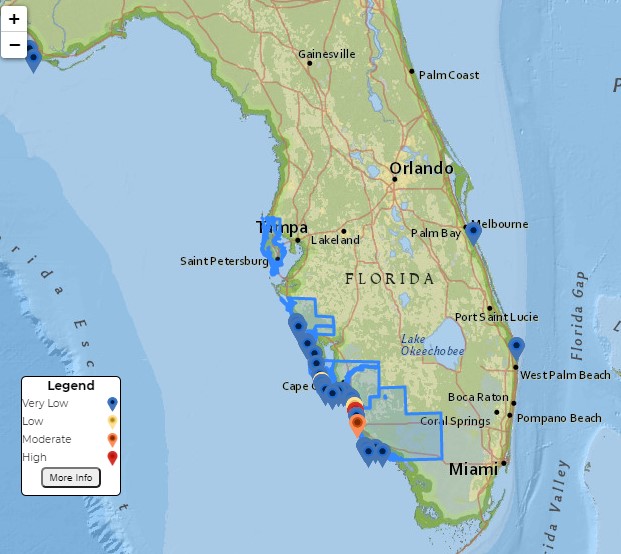
There is some good news in the works for Florida and Texas residents, visitors, and businesses susceptible to near-annual blooms of red tide in the Gulf of Mexico. Grants from NOAA’s National Centers for Coastal Ocean Science (NCCOS) and the U.S. Integrated Ocean Observing System (IOOS) will allow the Red Tide Respiratory Forecast to be expanded to more Gulf Coast beaches.
The forecast provides beach-level risk information during red tide events that tells beachgoers what red tide impacts are expected at individual beaches before they visit. The information is particularly important for people with asthma and other chronic lung diseases. Initially developed and tested in Pinellas County, Florida, the forecast was expanded to Lee County in 2018. Today, it includes more than 20 Gulf Coast beaches and is hosted by the Gulf of Mexico Coastal Ocean Observing System (GCOOS). The number of beaches participating on a daily basis varies, depending on red tide conditions.
Several groups are working together to expand the forecast to the Florida Panhandle and Texas beaches by recruiting more citizen science volunteers and providing them with the HABscope tool needed to process water samples for the forecast. The partners include scientists from NCCOS, GCOOS, Texas Sea Grant and their Red Tide Rangers, and Florida’s Fish and Wildlife Research Institute (FWRI).

Key to creating the Red Tide Respiratory Forecast is HABscope, a portable microscope system that uses video and artificial intelligence to quickly analyze water samples for near real-time cell counts of Karenia brevis, the organism that causes red tide in the Gulf of Mexico. Samples are collected by researchers and citizen science volunteers.
The funding from NOAA and IOOS will help GCOOS develop a wider network of volunteers to contribute samples to the forecast, enabling it to expand to new communities. In addition to getting more microscopes in more hands on more beaches, the funding from NCCOS’s MERHAB Program and IOOS will also help the team test whether the system can be used to detect other species of toxic algae harmful to humans.
The forecast will support both people, saving those susceptible to its impacts visits to their doctors and emergency rooms, and businesses that can lose thousands of dollars during red tides because visitors haven’t been able to make informed decisions about whether going to the beach is safe.
The Red Tide Respiratory Forecast was developed by NCCOS in partnership with GCOOS, FWRI, and Pinellas County Environmental Management through funding from the NASA Health and Air Quality Program.
To learn more, read the full GCOOS Press Release here, or visit the NCCOS project page.
